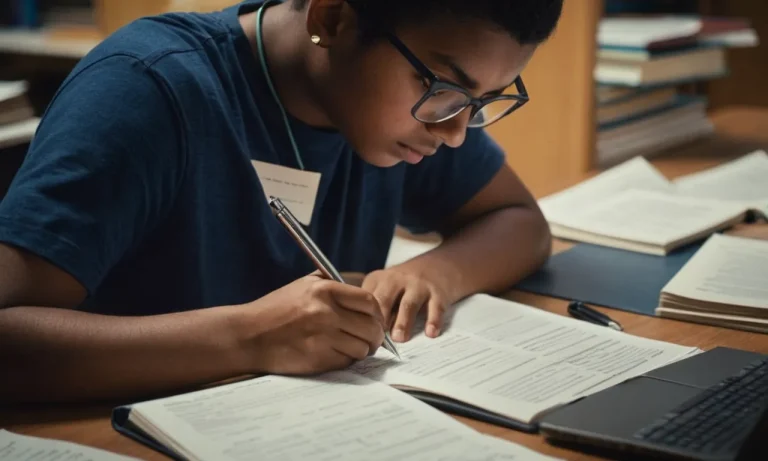Bringing a knife to school is a serious offense that can have severe consequences for students. It’s a violation of school policies and, in many cases, state and federal laws. Whether intentional or unintentional, carrying a knife on school premises can lead to disciplinary actions, legal repercussions, and even criminal charges.
If you’re short on time, here’s a quick answer to your question: Bringing a knife to school can result in suspension or expulsion, criminal charges, and potentially jail time, depending on the circumstances and local laws. It’s considered a safety threat and a violation of school policies and laws.
In this comprehensive article, we’ll explore the potential consequences of bringing a knife to school, including legal implications, school disciplinary actions, and the impact it can have on a student’s academic and personal life.
We’ll also discuss the importance of understanding school policies and laws related to weapons on campus.
School Disciplinary Actions
Bringing a knife or any other weapon to school is considered a serious offense that can have severe consequences for students. Schools have implemented various disciplinary measures to address such incidents and maintain a safe learning environment for everyone. Here are some common actions taken:
Suspension or Expulsion
In most cases, bringing a knife or weapon to school can lead to immediate suspension or even expulsion. According to the National Center for Education Statistics, in the 2017-18 school year, 36% of public schools reported taking at least one disciplinary action for incidents involving firearms or explosive devices, and 18% reported taking actions for incidents involving knives or other sharp objects.
Schools have a zero-tolerance policy towards weapons, and suspension or expulsion serves as a strong deterrent and consequence for such behavior. The duration of suspension or expulsion can vary based on the severity of the incident and the school’s policies.
Zero-Tolerance Policies
Many schools have adopted zero-tolerance policies when it comes to weapons on campus. These policies clearly outline the consequences for bringing weapons to school, leaving little room for exceptions or leniency.
The Education Week reports that 79% of public schools had zero-tolerance policies for firearms, and 94% had such policies for other weapons as of the 2015-16 school year. While these policies aim to create a safe environment, some argue that they can be too rigid and fail to consider individual circumstances.
🤔
Counseling and Intervention Programs
In addition to disciplinary actions, many schools offer counseling and intervention programs to address the root causes of such behavior. These programs aim to provide support, guidance, and resources to students who may be struggling with issues like bullying, mental health, or family problems.
Counselors work with students to help them develop coping mechanisms, conflict resolution skills, and positive decision-making abilities. The Centers for Disease Control and Prevention (CDC) recommends implementing evidence-based prevention programs to address violence and promote a positive school climate.
👍
Ultimately, schools strive to create a safe and nurturing environment for all students. While disciplinary actions are necessary to address serious incidents like bringing weapons to school, counseling and intervention programs can play a crucial role in preventing such incidents from occurring in the first place.
By fostering a culture of respect, empathy, and support, schools can help students make better choices and contribute to a positive learning environment for everyone.
Legal Consequences
Bringing a knife or any other type of weapon to school can have severe legal consequences that vary based on state and federal laws. It’s crucial to understand the gravity of this offense and the potential repercussions it can have on a student’s life. 😐
State and Federal Laws
Each state has its own set of laws and regulations regarding weapons on school premises. For instance, in California, it’s illegal to bring a knife with a blade longer than 2.5 inches on school grounds (California Penal Code 626.10).
Additionally, federal laws like the Gun-Free School Zones Act prohibit the possession of firearms within a certain distance from schools. 🚫
Criminal Charges
Depending on the type of weapon, its intended use, and the student’s age, bringing a knife to school can lead to criminal charges. These charges can range from misdemeanors to felonies, such as possession of a deadly weapon or carrying a concealed weapon.
In some cases, students may face charges like assault with a deadly weapon if they brandished or threatened someone with the knife. 😬
According to the Centers for Disease Control and Prevention (CDC), in the 2019-2020 school year, there were approximately 3.1 million students who reported carrying a weapon on school property. This alarming statistic highlights the importance of addressing this issue and educating students about the severe consequences of bringing weapons to school.
💯
Juvenile Justice System
If the offender is a minor, they may be processed through the juvenile justice system instead of the adult criminal court system. However, this doesn’t necessarily mean lighter consequences. Juvenile courts can impose various penalties, including probation, counseling, community service, or even detention in a juvenile facility.
😕
It’s important to note that a school’s zero-tolerance policy may also result in immediate suspension or expulsion, regardless of the legal consequences. This can have a significant impact on a student’s education and future opportunities.
Can you imagine the disappointment of being expelled from school for such a foolish mistake? 😔
Impact on Academic and Personal Life
Disruption of Education
Bringing a knife to school can have a severe impact on a student’s educational journey. It often results in immediate suspension or expulsion, causing significant disruptions to their academic progress.
According to a study by the National Center for Education Statistics, students who are suspended or expelled are more likely to fall behind academically and have a higher risk of dropping out of school. This can have long-lasting consequences on their future prospects and career opportunities.
Furthermore, the presence of a weapon on school premises creates an atmosphere of fear and insecurity, making it difficult for students to concentrate and learn effectively. The Centers for Disease Control and Prevention reports that students who feel unsafe at school are more likely to experience emotional distress, poor academic performance, and higher absenteeism rates.
😔 This can negatively impact not only the student who brought the knife but also their classmates and the entire school community.
Damage to Reputation
Bringing a knife to school can also have serious consequences for a student’s reputation and future prospects. In today’s digital age, such incidents can quickly spread through social media and online forums, potentially damaging the student’s online reputation.
This can make it challenging to secure admission to colleges or universities, as many institutions conduct thorough background checks on applicants.
Moreover, having a record of carrying a weapon to school can harm a student’s chances of securing employment or internships in the future. Employers often view such incidents as a red flag, questioning the individual’s judgment and potential risk to the workplace.
😕 Even if the student has learned from their mistake, the stigma associated with this act can linger, making it difficult to move forward and rebuild their reputation.
Emotional and Psychological Effects
The emotional and psychological impact of bringing a knife to school can be profound. Students may experience feelings of guilt, shame, and anxiety, which can take a toll on their mental well-being. According to the American Psychological Association, such incidents can lead to increased stress, depression, and even post-traumatic stress disorder (PTSD) in some cases.
Additionally, the consequences of this action, such as suspension or expulsion, can further exacerbate these emotional challenges. Being removed from the familiar school environment and separated from peers can heighten feelings of isolation and loneliness.
😞 It is crucial for students and their families to seek professional support and counseling to address these emotional and psychological effects, ensuring they can move forward in a healthy and positive manner.
Understanding School Policies and Laws
Bringing a knife or any other weapon to school can have serious consequences that go beyond the school’s disciplinary policies. It’s crucial to understand the laws and regulations surrounding weapon-free school zones, reporting procedures, and any potential exceptions or mitigating circumstances.
By being informed, students, parents, and educators can help maintain a safe learning environment for everyone.
Weapon-Free School Zones
Most states have laws establishing weapon-free school zones, which prohibit the possession of weapons within a certain radius of school property. These laws typically apply not only to students but also to anyone on school grounds, including visitors and staff.
According to the Center for Gun Violence Solutions, as of 2022, 48 states have laws prohibiting firearms on school grounds, with varying definitions of what constitutes a “weapon” and the extent of the designated zone.
Violating these laws can result in serious consequences, including criminal charges, fines, and potential jail time. For example, in Texas, bringing a weapon into a school zone is a felony offense punishable by up to 10 years in prison and a $10,000 fine. 🚨
Reporting Procedures
Schools typically have clear protocols in place for reporting incidents involving weapons on campus. These procedures often involve immediately notifying school administrators, security personnel, and law enforcement.
In many cases, schools are required by law to report such incidents to the appropriate authorities.
For example, the California Department of Education mandates that schools must have a comprehensive safety plan that includes procedures for dealing with students who bring weapons to school, as well as reporting requirements to law enforcement agencies. 👮♀️
Exceptions and Mitigating Circumstances
While the laws and policies surrounding weapons in schools are generally strict, there may be exceptions or mitigating circumstances that could potentially lessen the consequences. For instance, some states may have provisions for unintentional or inadvertent possession of a weapon, such as a student forgetting that they had a pocketknife in their backpack.
Additionally, the student’s age, intent, and disciplinary history may be taken into account when determining the appropriate disciplinary action. However, it’s important to note that these exceptions are typically evaluated on a case-by-case basis and may vary depending on the specific laws and policies of the school district or state.
🤔
Conclusion
Bringing a knife to school is a serious offense that can have far-reaching consequences for students. From suspension or expulsion to criminal charges and potential jail time, the repercussions can be severe and long-lasting.
It’s crucial for students, parents, and educators to understand and comply with school policies and laws related to weapons on campus.
By promoting a safe and secure learning environment, schools can foster an atmosphere conducive to academic success and personal growth. Educating students about the dangers and consequences of bringing weapons to school is essential in preventing such incidents and ensuring the well-being of the entire school community.






